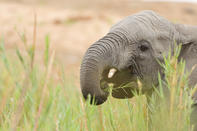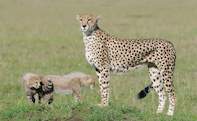From South to North
The western strip of the Kruger National Park is underlain by Old Granite and the eastern half composed of much younger Lebombo Basalts (of the Karoo's Stormberg Group). Rainfall decreases steadily from south to north.

The broad ecosystems within the park are determined by the intersection of these two environmental gradients, modified the seven main rivers that traverse the park from west to east.
The Olifants River more or less bisects the park, acting as a dividing line between the two main vegetation zones: mopane woodlands, studded with the massive forms of baobab trees, stretch over the deep, loamy soils north of the river; in the south-west mixed acacia and combretum savanna grows on the relatively poor granitic soils, while open grassland with scattered, large marula, acacia, knobthorn and umbrella thorn trees grow on the richer basaltic soils in the south-east.
Prey Meet Predators
Twenty species of antelope are found in the Kruger Park, all of which might be expected to compete for the same food resource. However, close observation reveals that each species occupies a slightly different niche. The delicate mouth of the steenbok requires it to nibble green shoots, while tsessebe will be found feeding in tall, coarse grasslands on the edge of woodlands. Impala will graze green grass and browse on seed pods, leaves and flowers, while the han some roan depend entirely on medium to long grasses, especially red grass (Themeda triandra) in open woodlands.
Where there is prey, there will be predators. Like the antelope the carnivores and scavengers have their own niches, with different favourite prey and different methods of hunting. While it would seem logical that the predators determine the numbers of prey that seem logical that can survive in the park, in fact it is the other way around.
Lions are so powerful that they can bring down grown buffalo, but they often prefer to scavenge the kills of subordinate predators. Cheetahs have slight frames and rely on bursts of great speed to bring down small antelope.

Cheetahs and wild dogs hunt in daylight, hyenas and leopards are mainly nocturnal killers, while in different areas lions will hunt by night or day. Visitors to the park may see a kill, but early risers are often rewarded by seeing an early hunt or a pride of lions feeding on a fresh carcass, with spotted hyenas and vultures in close attendance.
Sunrise is a fine time to be up and observant here: a line of bee-eaters may be illuminated, huddled together on a branch like a be-jewelled brooch, before flitting off into the crisp air; the new day's sunlight sparkles on the dew-hung grass; animals stir and sniff the fresh breeze - this is dawn just as the first person would have experienced it.